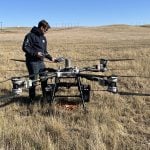
Tag Archives crop spraying

Farm-facing drone does the heavy lifting
The AGRAS T100 drone helps streamline a variety of jobs that are required on Prairie farms

How non-stop rain affects your farm equipment
Be careful what you wish for in those dry years

Be wary when asked about spraying with drones
Farmers may ask for advice, but answering may get you in hot water

VIDEO: Drone sprayer offers large carrying capacity

Spraying facts, fallacies and forethought
Experts share tips on what you need to know before you spray

Green-on-green tech prepares for airborne launch
A Saskatchewan-based startup is testing precision drone spraying on the Prairies this spring, but there’s no word yet on a regulatory framework to allow full commercialization

Use Delta T values for successful spray operations in hot and dry weather
It’s a better indicator than relative humidity for gauging evaporation rate

Four tips for FHB spray applications in wheat
To prevent outbreaks consider spray preparation, double nozzles, coarser sprays and lower booms

Ten tips for spraying in windy conditions
Here’s how to optimize pesticide coverage and reduce spray drift risks

Save time with spray operation efficiencies
Covering more acres in a day doesn’t mean you need to drive faster


